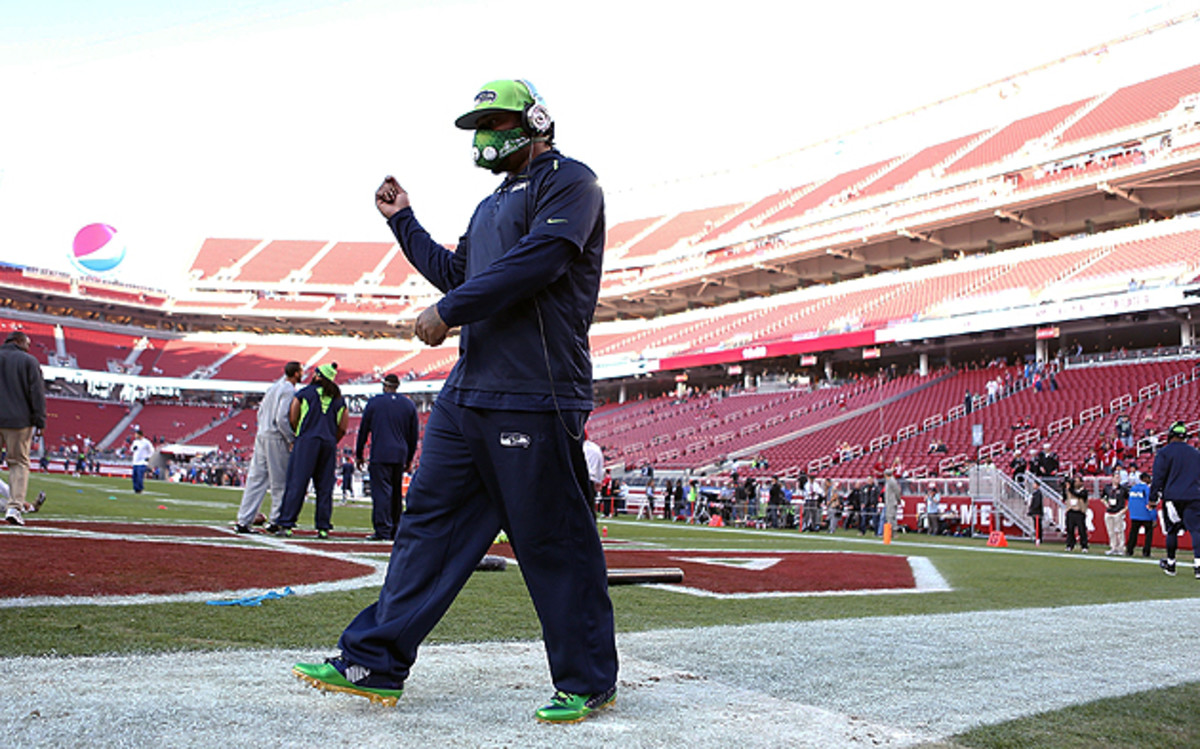The story behind Marshawn Lynch’s unique high-altitude training mask

As Super Bowl XLIX approaches, the overwhelming focus of media attention has been on the Patriots’ inability to properly inflate their footballs and Marshawn Lynch’s desire to avoid talking with the press. However, in a recent sit down with SI.com, the Seahawks' headline-generating running back finally opened up, speaking on his upbringing in Oakland, his recently launched apparel brand, Beast Mode, and the unique breathing device he has been spotted wearing, the Elevation Training Mask.
- Super Bowl XLIX: News, features | Complete coverage of Deflategate
Back in September, Lynch was first seen wearing the Bane-like mask during his pregame warmups as the Seahawks prepared to face the Chargers in a Week 2 matchup. From there, speculation began to spread through the blogosphere about what it was, what one of the graphics printed on the mask depicted and why he was wearing it in the first place. So how exactly did the relatively unknown training mask end up on the face of one of the NFL’s most popular players?
Behind The Brand: Marshawn Lynch opens up about 'Beast Mode'
“One my homeboys back home, Troy, he came in with one of the masks and was like, ‘Man, you need to work out with this. It’s like working out 10 times harder than normally working out,’” says Lynch. “And I was like, ‘Why would I want to do that?’” Lynch laughs. “He was like, ‘Man, you just have to try it.’”
According to Casey Danford, CEO of Elevation Training Mask, Lynch called the company’s sales department looking to purchase the device and the rest was history. It began showing up on the star running back’s face during pregame warmups, drew a lot of attention for the custom designs as well as the strange appearance of the mask, which some likened to the Silence of the Lambs’ Hannibal Lechter and to the Batman villain, Bane. The Seahawks star doesn’t have a deal with Elevation Training Mask, although Danford says they’re happy to overnight him any gear he needs.

“I put the mask on, and I probably did a lap around the building where we train, and, like, halfway through the lap, I had to take it off and stop,” says Lynch. “I was breathing hard, and thinking, ‘Man, this is a little different than what I was expecting.’ So I get back, and Troy is like, ‘Man, you just got to try and finish through.’ And I started to notice, three days of working out with it, like my wind got that much better. And I was like, ‘Whoa. It works.’”
The model that Lynch uses, Training Mask 2.0, uses three different resistance valves to regulate breathing in an effort to simulate a high-elevation environment, similar to the effect athletes get from training in high-altitude destinations, such as Colorado. The training aid can be adjusted to mimic elevations from 3,000 to 18,000 feet, which incrementally builds lung capacity and works to heighten Lynch’s overall mental focus.
Behind the NFL's yellow first down line, and what's next for sports TV
, the mask conditions Lynch’s lungs by creating pulmonary resistance and strengthening the 5-foot-11 running back’s diaphragm. When Lynch’s lungs are forced to work harder, the surface area and elasticity in the alveoli are increased, which helps build up his stamina. The valve system makes Lynch inhale fuller, deeper breaths. As his body adapts, his lungs learn to take deeper breaths and to use the available oxygen more efficiently.
Lynch has been seen wearing the mask during pregame warmups, which, Danford says, allows the Seahawks star to actually stretch out his lung capacity for the short term. When he takes off the mask his lungs have been conditioned in this simulated, high-altitude environment, which allows Lynch to get a “boost” just minutes before the game.
“With the pregame thing, I don’t like to run around a lot. So, when I do my laps around the field, and I have the mask on, it gets my heart rate up a little, it makes me breath a little bit harder,” says Lynch. “So instead of going and just running around and doing a whole lot of drills, I just get my mask on, and I get my little boost like...” (Lynch takes deep breaths and exhales) “...Okay, it’s time to go to war.”
Additional reporting by Sports Illustrated’s Aaron Nagler and Tim Newcomb.
